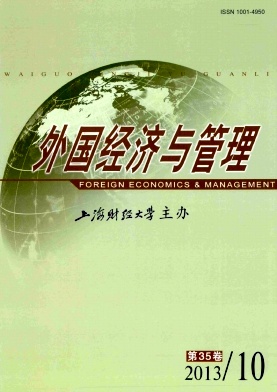领导—成员交换理论的新拓展——相对领导—成员交换关系研究综述
外国经济与管理 2013 年 第 35 卷第 10 期, 页码:72 - 80
摘要
参考文献
摘要
相对领导—成员交换关系(RLMX)是领导—成员交换关系(LMX)在群体内个体层次的相应构念,是员工个体将自身的LMX与团队LMX均值进行比较的差值,分为客观与主观两类。本文对RLMX构念的内涵、测量、影响因素、影响效果和作用机制等方面的研究成果进行了梳理,并在此基础上对未来研究方向进行了展望。
[1]Bernerth J B,Armenakis A A,Feild H S,Giles W F and Wal-ker H J.Leader-member social exchange(LMSX)develop-ment and validation of a scale[J].Journal of OrganizationalBehavior,2007,28(8):979-1003.
[2]Blau P M.Exchange and power in social life[M].New York:Wiley,1964.
[3]Buunk A P and Gibbons F X.Social comparison:The end of atheory and the emergence of a weld[J].Organizational Beha-vior and Human Decision Processes,2007,102(1):3-21.
[4]Dansereau F,Alutto J A and Yammarino F J.Theory testingin organizational behavior:The variant approach[M].Engle-wood Cliffs,NJ:Prentice-Hall,1984.
[5]Dulebohn J H,Bommer W H,Liden R C,Brouer R L and Fer-ris G R.A meta-analysis of antecedents and consequences ofleader-member exchange:Integrating the past with an eye to-ward the future[J].Journal of Management,2012,38(6):24-36.
[6]Edwards J R and Parry M E.On the use of polynomial regres-sion equations as an alternative to difference scores in organi-zational research[J].Academy of Management Journal,1993,36(6):1577-1613.
[7]Erdogan B and Bauer T N.Differentiated leader-member ex-change:The buffering role of justice climate[J].Journal ofApplied Psychology,2010,95(6):1104-1120.
[8]Festinger L.A theory of social comparison processes[J].Hu-man Relation,1954,7(2):117-140.
[9]Foa U G and Foa E B.Societal structures of the mind[M].Springfield,IL:Charles C Thomas,1974.
[10]Gerstner C R and Day V D.Meta-analytic review of leader-member exchange theory:Correlates and construct issues[J].Journal of Applied Psychology,1997,82(6):827-844.
[11]Gouldner A W.The norm of reciprocity:A preliminary state-ment[J].American Sociological Review,1960,25(2):161-178.
[12]Graen G,Dansereau F,Jr.and Minami T.Dysfunctional lea-dership styles[J].Organizational Behavior and Human Per-formance,1972,7(2):216-236.
[13]Graen G,Liden R C and Hoel W.Role of leadership in theemployee withdrawal process[J].Journal of Applied Psycho-logy,1982,67(6):868-872.
[14]Graen G B and Uhl-Bien M.Relationship-based approach toleadership:Development of leader-member exchange(LMX)theory of leadership over 25years:Applying a multi-levelmulti-domain perspective[J].Leadership Quarterly,1995,6(2):219-247.
[15]Greenberg J,Ashton-James C E and Ashkanasy N M.Socialcomparison process in organizations[J].Organizational Be-havior and Human Decision Process,2007,102(1):22-41.
[16]Henderson D J,Wayne S J,Shore L M,Bommer W H andTetrick L E.Leader-member exchange,differentiation,andpsychological contract fulfillment:A multilevel examination[J].Journal of Applied Psychology,2008,93(6):1208-1219.
[17]Henderson D J,Liden R C,Glibkowski B C and Chaudhry A.LMX differentiation:A multilevel review and examination ofits antecedents and outcomes[J].Leadership Quarterly,2009,20(4):517-534.
[18]Hu J and Liden R C.Relative leader-member exchange withinteam contexts:How and when social comparison impacts in-dividual effectiveness[J].Personnel Psychology,2013,66(1):127-172.
[19]Kristof-Brown A,Zimmerman R D and Johnson E C.Conse-quences of individual’fit at work:A meta-analysis of person-job,person-organization,person-group and person-supervisorfit[J].Personnel Psychology,2005,58(2):281-342.
[20]Ma L and Qu Q.Differentiation in leader-member exchange:A hierarchical linear modeling approach[J].LeadershipQuarterly,2010,21(5):733-744.
[21]Schriesheim C A,Neider L L and Scandura T A.A within-and between-groups analysis of leader-member exchange as acorrelate of delegation and as a moderator of delegation rela-tionships with performance and satisfaction[J].Academy ofManagement Journal,1998,41(3):298-318.
[22]Schriesheim C A,Castro S L and Yammarino F J.Investiga-ting contingencies:An examination of the impact of span ofsupervision and upward controllingness on leader-memberexchange using traditional and multivariate within-and be-tween-entities analysis[J].Journal of Applied Psychology,2000,85(5):659-677.
[23]Sias P M and Jablin F M.Differential superior-subordinaterelations,perceptions of fairness,and coworker communica-tion[J].Human Communication Research,1995,22(1):5-38.
[24]Tse H H M,Ashkanasy N M and Dasborough M T.Relativeleader-member exchange,negative affectivity and social iden-tification:A moderated-mediation examination[J].Leader-ship Quarterly,2012,23(3):354-366.
[25]Vidyarthi P R,Liden R C,Anand S,Erdogan B and Ghosh S.Where do I stand?Examining the effects of leader-memberexchange social comparison on employee work behaviors[J].Journal of Applied Psychology,2010,95(5):849-961.
[26]Wood J V.What is social comparison and how should westudy it?[J].Personality and Social Psychology Bulletin,1996,22(5):520-537.
[27]郭晓薇.中国情境中的上下级关系构念研究述评——兼论领导—成员交换理论的本土贴切性[J].南开管理评论,2011,14(2):61-68.
[28]任孝鹏,王辉.领导—部属交换(LMX)的回顾与展望[J].心理科学进展,2005,13(6):788-797.
[29]王震,仲理峰.领导—成员交换关系差异化研究评述与展望[J].心理科学进展,2011,19(7):1037-1046.
[30]徐淑英,欧怡.科学过程与研究设计[A].陈晓萍,徐淑英,樊景立(编).组织与管理研究的实证方法(第一版)[C].北京:北京大学出版社,2008:15-16.
[2]Blau P M.Exchange and power in social life[M].New York:Wiley,1964.
[3]Buunk A P and Gibbons F X.Social comparison:The end of atheory and the emergence of a weld[J].Organizational Beha-vior and Human Decision Processes,2007,102(1):3-21.
[4]Dansereau F,Alutto J A and Yammarino F J.Theory testingin organizational behavior:The variant approach[M].Engle-wood Cliffs,NJ:Prentice-Hall,1984.
[5]Dulebohn J H,Bommer W H,Liden R C,Brouer R L and Fer-ris G R.A meta-analysis of antecedents and consequences ofleader-member exchange:Integrating the past with an eye to-ward the future[J].Journal of Management,2012,38(6):24-36.
[6]Edwards J R and Parry M E.On the use of polynomial regres-sion equations as an alternative to difference scores in organi-zational research[J].Academy of Management Journal,1993,36(6):1577-1613.
[7]Erdogan B and Bauer T N.Differentiated leader-member ex-change:The buffering role of justice climate[J].Journal ofApplied Psychology,2010,95(6):1104-1120.
[8]Festinger L.A theory of social comparison processes[J].Hu-man Relation,1954,7(2):117-140.
[9]Foa U G and Foa E B.Societal structures of the mind[M].Springfield,IL:Charles C Thomas,1974.
[10]Gerstner C R and Day V D.Meta-analytic review of leader-member exchange theory:Correlates and construct issues[J].Journal of Applied Psychology,1997,82(6):827-844.
[11]Gouldner A W.The norm of reciprocity:A preliminary state-ment[J].American Sociological Review,1960,25(2):161-178.
[12]Graen G,Dansereau F,Jr.and Minami T.Dysfunctional lea-dership styles[J].Organizational Behavior and Human Per-formance,1972,7(2):216-236.
[13]Graen G,Liden R C and Hoel W.Role of leadership in theemployee withdrawal process[J].Journal of Applied Psycho-logy,1982,67(6):868-872.
[14]Graen G B and Uhl-Bien M.Relationship-based approach toleadership:Development of leader-member exchange(LMX)theory of leadership over 25years:Applying a multi-levelmulti-domain perspective[J].Leadership Quarterly,1995,6(2):219-247.
[15]Greenberg J,Ashton-James C E and Ashkanasy N M.Socialcomparison process in organizations[J].Organizational Be-havior and Human Decision Process,2007,102(1):22-41.
[16]Henderson D J,Wayne S J,Shore L M,Bommer W H andTetrick L E.Leader-member exchange,differentiation,andpsychological contract fulfillment:A multilevel examination[J].Journal of Applied Psychology,2008,93(6):1208-1219.
[17]Henderson D J,Liden R C,Glibkowski B C and Chaudhry A.LMX differentiation:A multilevel review and examination ofits antecedents and outcomes[J].Leadership Quarterly,2009,20(4):517-534.
[18]Hu J and Liden R C.Relative leader-member exchange withinteam contexts:How and when social comparison impacts in-dividual effectiveness[J].Personnel Psychology,2013,66(1):127-172.
[19]Kristof-Brown A,Zimmerman R D and Johnson E C.Conse-quences of individual’fit at work:A meta-analysis of person-job,person-organization,person-group and person-supervisorfit[J].Personnel Psychology,2005,58(2):281-342.
[20]Ma L and Qu Q.Differentiation in leader-member exchange:A hierarchical linear modeling approach[J].LeadershipQuarterly,2010,21(5):733-744.
[21]Schriesheim C A,Neider L L and Scandura T A.A within-and between-groups analysis of leader-member exchange as acorrelate of delegation and as a moderator of delegation rela-tionships with performance and satisfaction[J].Academy ofManagement Journal,1998,41(3):298-318.
[22]Schriesheim C A,Castro S L and Yammarino F J.Investiga-ting contingencies:An examination of the impact of span ofsupervision and upward controllingness on leader-memberexchange using traditional and multivariate within-and be-tween-entities analysis[J].Journal of Applied Psychology,2000,85(5):659-677.
[23]Sias P M and Jablin F M.Differential superior-subordinaterelations,perceptions of fairness,and coworker communica-tion[J].Human Communication Research,1995,22(1):5-38.
[24]Tse H H M,Ashkanasy N M and Dasborough M T.Relativeleader-member exchange,negative affectivity and social iden-tification:A moderated-mediation examination[J].Leader-ship Quarterly,2012,23(3):354-366.
[25]Vidyarthi P R,Liden R C,Anand S,Erdogan B and Ghosh S.Where do I stand?Examining the effects of leader-memberexchange social comparison on employee work behaviors[J].Journal of Applied Psychology,2010,95(5):849-961.
[26]Wood J V.What is social comparison and how should westudy it?[J].Personality and Social Psychology Bulletin,1996,22(5):520-537.
[27]郭晓薇.中国情境中的上下级关系构念研究述评——兼论领导—成员交换理论的本土贴切性[J].南开管理评论,2011,14(2):61-68.
[28]任孝鹏,王辉.领导—部属交换(LMX)的回顾与展望[J].心理科学进展,2005,13(6):788-797.
[29]王震,仲理峰.领导—成员交换关系差异化研究评述与展望[J].心理科学进展,2011,19(7):1037-1046.
[30]徐淑英,欧怡.科学过程与研究设计[A].陈晓萍,徐淑英,樊景立(编).组织与管理研究的实证方法(第一版)[C].北京:北京大学出版社,2008:15-16.
引用本文
杨晓, 师萍, 安立仁. 领导—成员交换理论的新拓展——相对领导—成员交换关系研究综述[J]. 外国经济与管理, 2013, 35(10): 72–80.
导出参考文献,格式为:





 8064
8064  393
393

